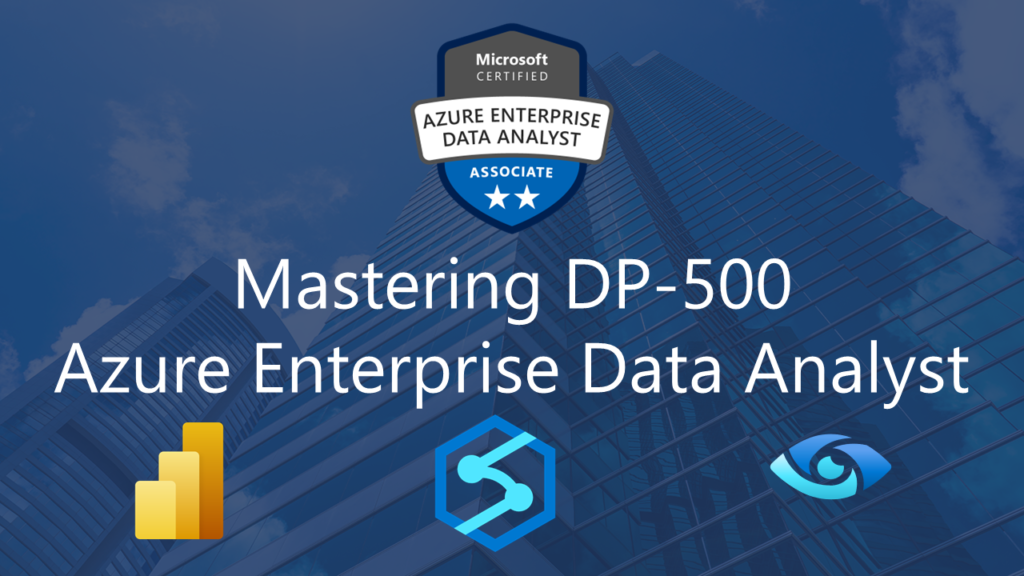DP-500 Certification
DP-500 exam (Enterprise Data Analyst) covers a broad range of skills and tools – starting with Power BI advanced features and concepts, all the way to Azure Synapse Analytics and Microsoft Purview.
I’ve created this page with the intention to keep all the learning resources in one single place. I hope that everyone who’s preparing to take this exam will find the page useful and that will in the end help you master all the necessary skills to become a certified Enterprise Data Analyst.
Contents
Table of contents
Implement and manage a data analytics environment (25–30%)
Govern and administer a data analytics environment
- Manage Power BI assets by using Azure Purview
- Identify data sources in Azure by using Azure Purview
- Recommend settings in the Power BI admin portal
- Recommend a monitoring and auditing solution for a data analytics environment, including Power BI REST API and PowerShell cmdlets
Integrate an analytics platform into an existing IT infrastructure
- Identify requirements for a solution, including features, performance, and licensing strategy
- Configure and manage Power BI capacity
- Recommend and configure an on-premises gateway in Power BI
- Recommend and configure a Power BI tenant or workspace to integrate with Azure Data Lake Storage Gen2
- Integrate an existing Power BI workspace into Azure Synapse Analytics
Manage the analytics development lifecycle
- Commit code and artifacts to a source control repository in Azure Synapse Analytics
- Recommend a deployment strategy for Power BI assets
- Recommend a source control strategy for Power BI assets
- Implement and manage deployment pipelines in Power BI
- Perform impact analysis of downstream dependencies from dataflows and datasets
- Recommend automation solutions for the analytics development lifecycle, including Power BI REST API and PowerShell cmdlets
- Deploy and manage datasets by using the XMLA endpoint
- Create reusable assets, including Power BI templates, Power BI data source (.pbids) files, and shared datasets
Query and transform data (20–25%)
Query data by using Azure Synapse Analytics
- Identify an appropriate Azure Synapse pool when analyzing data
- Recommend appropriate file types for querying serverless SQL pools
- Query relational data sources in dedicated or serverless SQL pools, including querying partitioned data sources
- Use a machine learning PREDICT function in a query
Ingest and transform data by using Power BI
- Identify data loading performance bottlenecks in Power Query or data sources
- Implement performance improvements in Power Query and data sources
- Create and manage scalable Power BI dataflows
- Identify and manage privacy settings on data sources
- Create queries, functions, and parameters by using the Power Query Advanced Editor
- Query advanced data sources, including JSON, Parquet, APIs, and Azure Machine Learning models
Implement and manage data models (25-30%)
Design and build Tabular models
- Direct Query in Power BI: What, when and why? ******** Watch on YouTube
- External Tools in Power BI ********* Watch on YouTube
- Creating Calculation groups
- DAX variables, virtual relationships and iterators
- Design and Build a Large Format Dataset ******** Watch on YouTube
- Design and Build Composite Models
- Aggregations in Power BI ************Watch on YouTube
- Design Row-level and Object-level security in Power BI
Optimize enterprise-scale data models
- Identify and implement performance improvements in queries and visuals
- Troubleshoot DAX performance by using DAX Studio ************ Watch on YouTube
- Optimize data model by using Tabular Editor 2
- Analyze data model efficiency by using VertiPaq Analyzer
- Implement incremental refresh
- Optimize data model by using denormalization
Explore and visualize data (20-25%)
Explore Data by using Azure Synapse Analytics
- Explore data using Spark notebooks
- Explore and visualize data using Synapse SQL pane ********* Watch on YouTube
Visualize Data by using Power BI
- Configure automatic page refresh
- Create and import a custom report theme
- Create and distribute paginated reports in Power BI Report Builder
- Create R or Python visuals in Power BI
- Connect to and query datasets by using the XMLA endpoint
- Design and configure Power BI reports for accessibility
- Enable personalized visuals in a report

